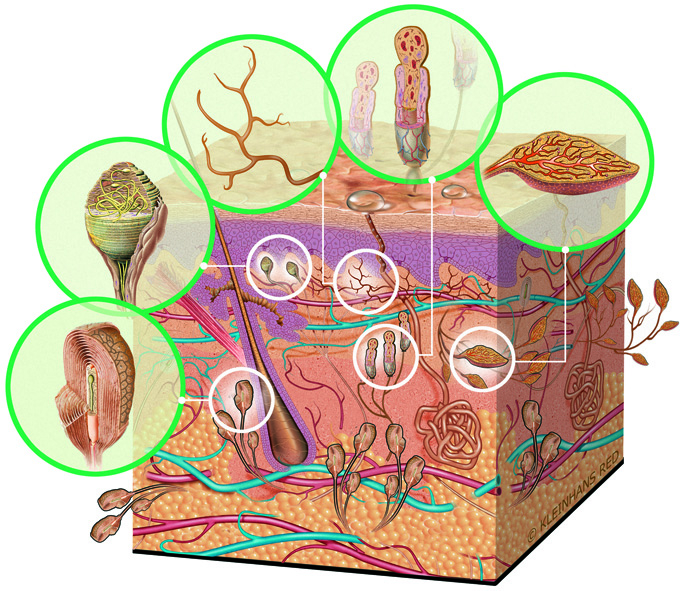The skin as a sense and communication organ

Among the major tasks of the skin is its function as a sense organ and its function to communicate with the environment. Mechanic and thermal stimuli as well as pain stimuli are perceived by a series of receptors which render the skin into a sense organ. Through reddening, paling and other manifestations of the vegetative nerve fibres the skin becomes an organ of communication transmitted by the vegetative nervous system, and thus a communication organ.
The sensors or receptors of the skin comprise the Vater-Pacini lamellar corpuscules, Meissner's touch corpuscules, intraepithelial nerve endings, corpuscules of Ruffini as well as Krause endbulbs (see Figure, from left to right).
The Vater-Pacini corpuscules are oval bodies. They are the largest lamellar corpuscules among the nervous end organs. Due to their high sensibility the corpuscules are able to perceive the smallest vibrations. They are pressure and tension receptors as well as vibration and shock receptors. The Pacinian receptors are furthermore excited by deformation, pressure or decompression, if pressure persists, they turn off. They are up to 4 millimeters in length and have an average size of approximately 2 millimeters. Their structure is onion-like. On average, there are 20-40 layered lamellae which are separated by interstitial fluid space.
Meissner's touch corpuscules or touch discs are receptors for touch. They are found below the epidermis in the hairless skin of the papilla and are long oval, cone-like touch corpuscules in the corium. They consist of obliquely piled up sensory cells and helical markless nervous fibres.
Intraepithelial nerve endings are sensitive nerve fibres in the skin which release perceptions of warmth, cold, pain, touch and pressure.
The corpuscules of Ruffini are found in the corium and in the subcutis, are made up of extended nets of markless nerve fibres which are 0.25 - 1.5 mm in length and are thought to be receptors for expansion.
Krause end bulbs are bulb-like mechanoreceptors with tangled, winding axons surrounded by a capsule. They mostly occur in the mucous membrane of the mouth and the tongue.
Source: Leonhardt, H., Histologie, Zytologie und Mikroanatomie des Menschen, Volume 3, Thieme 1990; Roche Lexikon Medizin, Ed. Urban & Schwarzenberg, 3. Auflage 1993.
